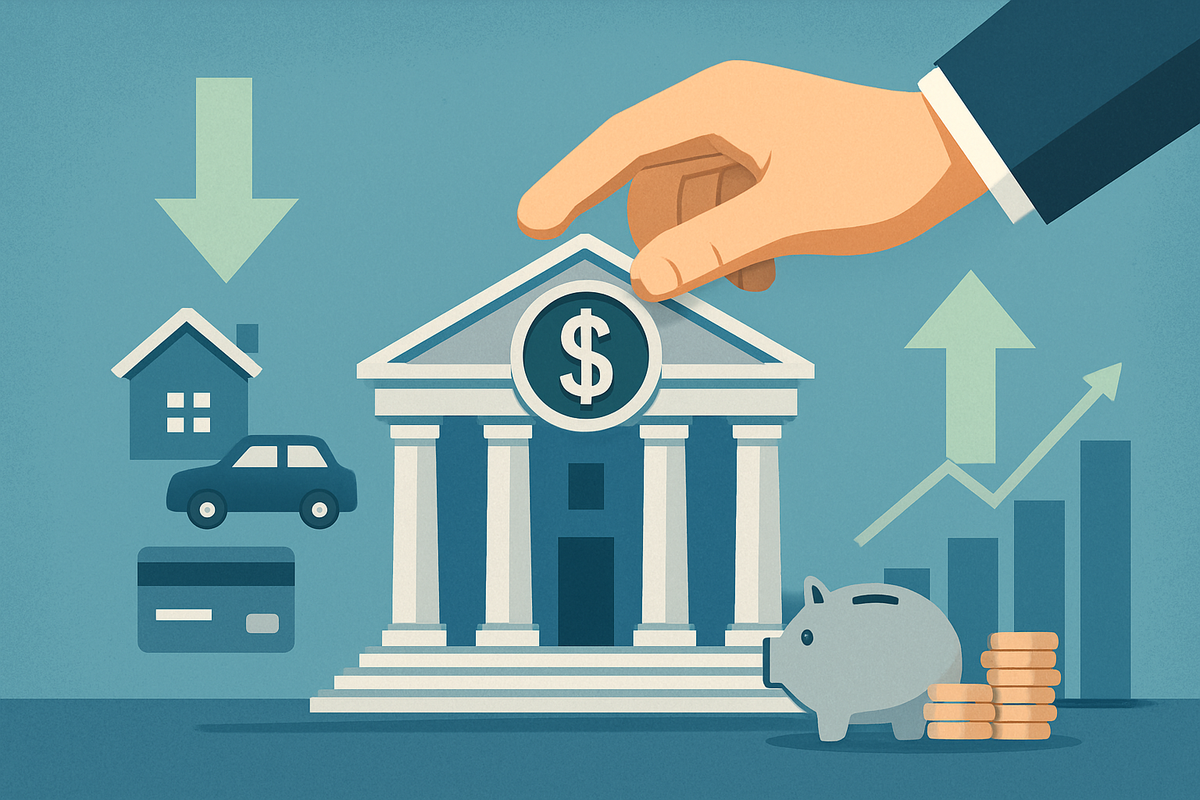
In a move widely anticipated by financial markets, the Federal Reserve recently announced a significant cut to the federal funds rate, signaling a strategic shift aimed at bolstering economic activity amidst evolving global and domestic pressures. This decision, the first such adjustment in a considerable period, is poised to ripple through every corner of the American financial landscape, directly influencing the borrowing costs for consumers, the returns on savings, and the landscape of investment opportunities. For the average American household, this means a tangible recalibration of their personal finances, presenting both opportunities for savings and challenges for wealth accumulation.
The central bank's action is a clear signal of its intent to stimulate growth, making money cheaper to borrow for everything from mortgages and auto loans to credit card balances. While this might sound like music to the ears of debtors and prospective borrowers, it simultaneously ushers in an era of lower yields for savers, prompting a re-evaluation of traditional savings strategies. Investors, too, will find themselves navigating a new environment, where certain asset classes may become more attractive, while others face headwinds. Understanding these shifts is crucial for making informed financial decisions in the wake of the Fed's latest policy adjustment.
The Fed's Latest Move: A Deep Dive into the Rate Cut
The Federal Reserve, on October 29, 2025, enacted a 25-basis-point (0.25%) interest rate cut, bringing the target range for the federal funds rate down to 3.75%–4.00%. This pivotal decision marks the second such reduction this year, a strategic pivot from the tightening cycle that characterized previous periods. The move, largely anticipated by financial markets, underscores the Fed's proactive stance in navigating a complex economic landscape.
The rationale behind this latest rate reduction stems from a confluence of economic indicators signaling a need for stimulative action. Foremost among these concerns was a discernible weakening in the labor market, with employment figures showing a sharper-than-expected deceleration in job creation and a rise in the unemployment rate. Concurrently, broader indicators of economic growth, including GDP patterns and consumer confidence, pointed towards a sluggish environment, further exacerbated by a protracted government shutdown that clouded the economic outlook. While headline inflation had moderated to around 3.0% year-over-year, providing some flexibility, it remained slightly above the Fed's 2% target, necessitating a careful balancing act between supporting growth and managing price stability.
The path to this October rate cut began with signals of economic deceleration throughout the summer of 2025. Federal Reserve Chair Jerome Powell, in an August address, hinted at potential future adjustments, setting the stage for the Federal Open Market Committee (FOMC), the central decision-making body, to initiate an easing cycle with a 25-basis-point cut in September. Persistent signs of slowing job growth and economic activity through October solidified the FOMC's resolve, culminating in the unanimous vote for the latest reduction. Key players in this decision include the seven members of the Board of Governors, particularly Chair Jerome Powell, alongside the presidents of the twelve Federal Reserve Banks who contribute vital regional economic insights to the FOMC's deliberations.
Initial market reactions to the October 29th announcement were largely positive, reflecting that the cut was widely anticipated and perceived as a supportive measure for the economy. U.S. stock indexes, including the Dow Jones Industrial Average (NYSE: ^DJI), S&P 500 (NYSE: ^GSPC), and Nasdaq Composite (NASDAQ: ^IXIC), registered modest gains, as investors welcomed the prospect of lower borrowing costs boosting corporate profits. In the bond market, short-term Treasury yields fell, and bond prices rose, particularly for longer-duration bonds, while the U.S. dollar softened against major currencies. Industries such as mortgage and lending braced for downward adjustments in rates, anticipating a potential uptick in housing market activity and consumer lending.
Corporate Fortunes: Who Wins and Who Loses?
The Federal Reserve's decision to cut interest rates reverberates across various sectors of the economy, creating a distinct landscape of winners and losers among public companies. The overarching goal of lower rates is to stimulate borrowing and spending, but the impact is not uniform, largely depending on a company's debt structure, capital intensity, and sensitivity to consumer demand.
The Technology Sector stands to gain significantly. Growth-oriented tech firms, often reliant on debt financing for innovation, research and development, and aggressive expansion, will find their cost of capital reduced. This makes it cheaper to fund ambitious projects and can also spur increased merger and acquisition (M&A) activity. Companies like Microsoft (NASDAQ: MSFT), Apple (NASDAQ: AAPL), and Alphabet (NASDAQ: GOOGL), with their substantial cash flows and continuous investment in new technologies, are well-positioned. Fintech players like Block (NYSE: SQ), with exposure to consumer spending and credit products, could also see improved margins and reduced default risks.
The Real Estate and Homebuilding industries are direct beneficiaries. Lower interest rates translate into more affordable mortgage rates, stimulating buyer demand and boosting housing market activity. For homebuilders such as PulteGroup (NYSE: PHM), D.R. Horton (NYSE: DHI), and Lennar (NYSE: LEN), reduced borrowing costs for land acquisition, development, and construction loans enhance profitability and encourage new projects, potentially easing housing supply constraints. Suppliers to the construction industry, like Builders FirstSource (NYSE: BLDR), will also see increased demand. The Consumer Discretionary sector typically thrives in a low-rate environment. With reduced borrowing costs on credit cards, auto loans, and personal loans, consumers often find themselves with more disposable income. This encourages spending on non-essential goods and services, benefiting cruise lines like Carnival Corporation & plc (NYSE: CCL) and resort operators such as Las Vegas Sands Corp. (NYSE: LVS). Even the often-stable Utilities Sector can see advantages. Companies like Essential Utilities (NYSE: WTRG), Constellation Energy Corp. (NASDAQ: CEG), and Vistra Corp. (NYSE: VST), which typically carry substantial debt for infrastructure projects, will experience lower borrowing costs, improving their financial flexibility and profitability. Their stable dividend yields also become more attractive to income-seeking investors when bond yields decline.
Conversely, the Financials Sector, particularly large banks, may face challenges. While lower rates can stimulate loan demand, banks' net interest margins (NIM)—the difference between what they earn on loans and pay on deposits—can be compressed. This pressure on profitability could affect institutions like JPMorgan Chase (NYSE: JPM), Bank of America (NYSE: BAC), and to some extent, Goldman Sachs (NYSE: GS), despite potential benefits from increased capital market activity. Certain "Bond Proxy" Industries, traditionally favored for their stable dividends and defensive characteristics in high-interest-rate environments, might see a rotation of investor interest. While companies like Verizon Communications Inc. (NYSE: VZ) can benefit from refinancing debt at lower rates, the overall "risk-on" sentiment driven by rate cuts can lead investors to shift capital from these traditionally safe, income-generating assets towards growth stocks and cyclicals, diminishing their relative appeal. Additionally, savers will face lower returns on savings accounts, money market accounts, and certificates of deposit (CDs), making it less attractive to hold cash. The actual impact on individual companies will depend on their unique financial structures, market positions, and the broader economic trajectory, with effects often manifesting over several quarters.
Broader Economic Canvas: Unpacking the Wider Significance
The Federal Reserve's recent rate cut is more than just an adjustment to borrowing costs; it's a profound signal about the central bank's perception of the economy and its strategic intent. This move fits squarely into the broader economic trends of balancing inflation control with the imperative for economic stimulation, a perennial challenge for monetary policymakers. By lowering rates, the Fed aims to inject liquidity and encourage activity, particularly in the face of a weakening labor market and slowing growth. However, this delicate balancing act carries the inherent risk of potentially reigniting inflationary pressures if the economy is over-stimulated, especially given that inflation, while moderating, remains above the Fed's long-term target.
The ripple effects of this policy shift extend far beyond domestic borders and immediate financial markets. Domestically, lower borrowing costs intensify competition, allowing businesses to invest more aggressively in expansion, innovation, and marketing. This could lead to a surge in mergers and acquisitions and the emergence of new market entrants. Internationally, a weaker U.S. dollar, a common consequence of rate cuts, makes American exports more competitive globally, potentially putting pressure on foreign competitors and altering global supply chain dynamics. Emerging market economies, particularly those with significant dollar-denominated debt, could find servicing their obligations cheaper, potentially attracting increased capital inflows as investors seek higher yields outside the U.S.
From a regulatory and policy standpoint, the Fed's action could compel other central banks worldwide to consider similar easing measures to maintain currency stability and manage capital flows, potentially ushering in a synchronized global easing cycle. This environment might also intensify calls for fiscal prudence from governments, as lower interest rates can mask the true cost of servicing national debt. Financial market regulators may also increase their scrutiny of institutions to ensure their resilience against potential economic slowdowns. The Fed's communication strategy, now more transparent, aims to guide market expectations and ensure smoother adjustments, utilizing a comprehensive suite of tools beyond just rate adjustments, including potential changes to quantitative tightening programs.
Historically, rate-cutting cycles have often been a response to slowing economic growth, with the cuts themselves helping to sustain rather than dramatically accelerate it. While the stock market often reacts positively due to increased confidence and cheaper capital, the context is crucial; cuts made in anticipation of a recession can initially cause turbulence. The housing market, however, typically sees a positive correlation, with lower mortgage rates stimulating demand and construction. This current cycle, characterized by some as "risk management cuts" to preempt a slowing labor market despite lingering inflation concerns, highlights the complexity of the present economic environment and the Fed's cautious approach to avoid a deeper downturn.
The Road Ahead: Navigating the New Economic Landscape
The Federal Reserve's recent rate cut sets the stage for a dynamic period, presenting both immediate adjustments and long-term shifts for the economy and personal finances. In the short term, consumers can anticipate lower borrowing costs on variable-rate loans such as credit cards, auto loans, and potentially new mortgages, offering immediate relief on monthly payments. Businesses will find it cheaper to finance investments, fostering potential job creation and economic activity. However, savers will likely see reduced returns on traditional savings accounts and Certificates of Deposit (CDs). The stock market may experience continued volatility but could also see gains, particularly in growth sectors, while bond prices for existing higher-yield bonds are expected to appreciate.
Looking further ahead, the long-term possibilities hinge on the success of the Fed's strategy. If the cuts effectively stimulate borrowing and investment without reigniting significant inflation, we could see sustained economic growth and robust employment. Conversely, there's a risk that persistent inflationary pressures could emerge if the economy is over-stimulated, complicating future policy decisions. A prolonged low-interest-rate environment will also reshape the investment landscape, potentially leading investors to seek higher returns in alternative asset classes.
Strategic pivots are crucial for both consumers and businesses. Consumers should actively explore refinancing opportunities for high-interest debt, such as mortgages or credit card balances, to capitalize on lower rates. For savings, diversifying beyond traditional low-yield accounts into higher-yield online options or even considering short-term CDs to lock in rates before further declines, could be beneficial. Businesses, in turn, should leverage cheaper capital for strategic investments, expansion, and debt refinancing, while also closely monitoring consumer spending trends and adapting their growth strategies. Market opportunities abound, particularly in equity markets, where growth and technology sectors often thrive in a low-rate environment. International equities, gold, and even certain cryptocurrencies could also become more attractive due to a weaker U.S. dollar. In real estate, reduced borrowing costs may support property values and REIT performance. However, challenges include the low returns for savers, the ever-present risk of inflationary pressures, and potential market volatility if the Fed's actions diverge from overly optimistic investor expectations.
Several potential scenarios could unfold. A "soft landing" is the ideal outcome, where the rate cuts successfully stabilize the economy without triggering excessive inflation or a recession. Alternatively, a "stagflation light" scenario could see the cuts fail to significantly boost the economy while inflation remains stubbornly high. A "delayed recession" is also a possibility, where the cuts offer temporary relief before underlying weaknesses lead to a downturn. Investors should also be prepared for a "cut, pause, and reassess" approach from the Fed, rather than a continuous easing cycle, which could lead to periods of market disappointment.
Comprehensive Wrap-up: Navigating the New Financial Frontier
The Federal Reserve's recent back-to-back rate cuts in September and October 2025, bringing the federal funds rate to a target range of 3.75% to 4.00%, signify a pivotal shift in monetary policy. The central bank is now explicitly balancing its dual mandate of price stability and maximum employment, with a heightened focus on preventing a downturn in the labor market even as inflation remains somewhat elevated. This move, coupled with the cessation of quantitative tightening (QT) starting December 1, 2025, underscores an accommodative stance aimed at stimulating economic activity.
Moving forward, the market's trajectory will be heavily influenced by the interplay of these policies. Equity markets have already reacted positively, with major indices reaching new highs, driven by the prospect of lower borrowing costs for businesses. Bond markets have seen yields stabilize or fall slightly, and the end of QT is expected to further support bond prices. Consumers stand to benefit from reduced borrowing costs on variable-rate loans, but savers must contend with lower returns on their deposits. While some analysts anticipate further cuts in late 2025 and 2026, the Fed's future actions remain "data-dependent" and subject to the evolving economic landscape.
The lasting impact of these rate cuts could be a more prolonged period of moderate economic growth, underpinned by cheaper capital, but potentially at the cost of inflation remaining above target for longer. This complex balancing act will define the Fed's strategy in the coming months and years. Political dynamics, including the upcoming presidential term ending for Chair Powell in May 2026, also add a layer of uncertainty.
Investors should remain vigilant, closely monitoring key economic data, particularly inflation and labor market reports. Federal Reserve communications, including statements from Chair Powell and other FOMC members, will provide crucial cues on the pace and direction of future policy. The impact of the cessation of QT on Treasury markets and overall liquidity will also be a significant factor. Observing how different market sectors perform in this new interest rate environment, with interest-rate-sensitive sectors like technology expected to continue benefiting, will be key for navigating these shifting dynamics and identifying specific investment opportunities.
This content is intended for informational purposes only and is not financial advice






